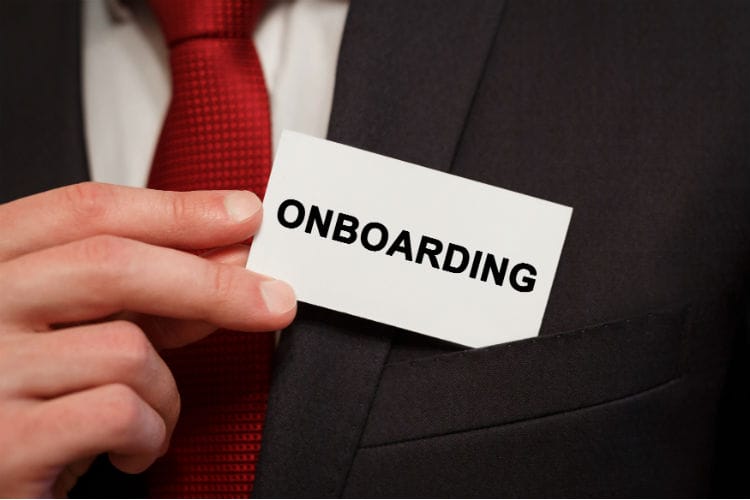Staffing Management
5 Easy Onboarding Strategies for Small Businesses
By Cheryl Strizelka
Dec. 26, 2018
The onboarding process is among the most critical parts of the employment experience and it sets the tone for an employee’s expectations throughout their time with an organization.
Implementing an effective onboarding strategy shows a new employee that the company is organized and excited for their arrival. Onboarding also doesn’t have to be expensive or time consuming. Here are some ways to enhance the onboarding process without breaking the bank.
Be prepared. In most situations, HR will have about two weeks to implement its onboarding strategy for a new employee to start, which is plenty of time to ensure the team is ready for their newest addition. Make sure managers build a realistic schedule, considerate of sufficient time for questions, hands on training, and breaks.
It helps to include employees in other departments who can loop the new hire in on ways their roles will impact each other. Notify the IT department as early as possible that someone new is starting and when. Ensuring the equipment, software, email address and key card badge are ready before the employee’s arrival streamlines a majority of the initial problems new hires general encounter.
Be thoughtful. Nothing is more uncomfortable for a new employee than having no idea what to expect during the first few days of their new job. They’re likely already overwhelmed with anxiety. “What do I wear? Who will I sit with at lunch?”

The best way to deal with those kinds of questions during the onboarding process is to answer them directly. Sending an email a few days before the employee’s start date outlining what time they should arrive, what they should wear, that they can expect breakfast and lunch with the team, and that they’ll be able to take off early. This is guaranteed to alleviate most first-day jitters.
A small swag bag for the new employee to dig through on their first day is a great touch. Throw in some candy, maybe a bottle of water or a small gift card to a local coffee shop. Include items with the company logo that you normally hand out to clients or at conferences.
Get integrated. It’s vital through the onboarding process that a new employee starts to feel like they’re part of the team as quickly as possible. To get ahead of the game, email the new hire a week before they start to get some fun facts about their life and post them for the staff to see before the start date. This opens the door for friendly conversation and allows the new hire to relate to their colleagues immediately.
For any employee’s first day, facilitate a 20- to 30-minute all-hands breakfast in a common space so everyone can take a moment to put a face with a name. This doesn’t have to be terribly expensive. Doughnuts for 40 people costs about $25 and the experience takes the edge off typically boring or intimidating introductions.
And ask a manager to plan a lunch and invite anyone who identifies as part of the team’s nucleus. This is a great bonding experience and only has to cost the price of the lunch for the manager and the new employee. To avoid the expense all together, invite the team to enjoy lunch together in the break room to get better acquainted.
Stay organized. During the onboarding process the HR professional should check in with the new hire regularly to make sure they have everything they need or aren’t too overwhelmed. Most new employees feel embarrassed to ask questions and don’t want to seem like a squeaky wheel. It helps to have several points of contact that the employee feels comfortable approaching, including an HR professional, an office administrator and a receptionist.
Also read: Shortened Onboarding Times See Mixed Results
Also read: Onboarding Tips HR Leaders Can Adopt from the First Day of School
These friendly faces should offer to make themselves available for any issues the new hire may encounter. To alleviate some of the more common questions, go ahead and give a facilities tour early in the process. Show the employee where the bathroom, water cooler and supply room are. Make them feel at home as quickly as possible.
Follow up. Most crucial to this entire onboarding process is the follow-up. Call a new employee in a month or two after their first day and get their insight into the process. Find out how they’re transitioning onto the team as a whole and ensure they have the resources they need to do their job well. Schedule a session for a group of new hires who started around the same time so they can talk about their experiences together. Every time an employee makes a suggestion, they provide a gift. Use their feedback for future onboarding hacks to create an even better experience for the next round of newbies.
While effective onboarding may seem daunting, or to some, a formality at best, it actually sets the tone for your new hire’s overall employment experience. Companies should invest time and energy into ensuring new employees transition successfully to their new position through an onboarding strategy. While managers technically absorb this responsibility once formal training begins, it behooves human resources representatives to facilitate the onboarding process behind the scenes.
After all, it’s HR’s job to maintain a healthy company culture and overall fulfillment.
Schedule, engage, and pay your staff in one system with Workforce.com.